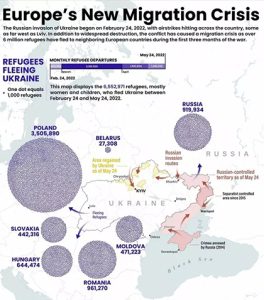New map reveals extent of Ukrainian exodus
Since Russia’s invasion of Ukraine in February, around 6.6 million people have fled to neighbouring countries.
Poland has seen the highest number of Ukrainian refugees with an estimated 3.5 million, of which 94 per cent have been women and children. Millions more people have been internally displaced, trapped within Ukraine.
 A fascinating yet disturbing new map gives a visual dimension to what is the largest crisis Europe has seen since the Second World War.
A fascinating yet disturbing new map gives a visual dimension to what is the largest crisis Europe has seen since the Second World War.
The map by cartographer and geographer Elbie Bentley, and published by the World Economic Forum, uses immigration data from the UN Refugee Agency UNHCR from the period to late May, 2022 to visualise the current migration crisis happening across Europe. It shows where Ukrainian refugees have crossed borders as they fled the conflict.
On February 24, 2022, Russia launched a full-scale military invasion of Ukraine. Since then, millions of Ukrainians have fled their homes in search of refuge, with a majority heading through neighbouring countries like Poland and Romania.
Poland has seen the highest number of Ukrainian refugees, with an estimated 3.5 million people crossing the border since February 24th. About a million of those refugees have been registered in Poland, and 94 per cent of those registered refugees have been women and children.
Hungary has seen the fourth-largest influx of refugees, seeing 644,474 Ukrainians cross into the country since the start of the conflict.
Tens of thousands of Ukrainians have made their way to other countries with Germany accepting 780,000 Ukrainian refugees since the start of the war, despite not sharing a border directly with Ukraine.
While many Ukrainians had fled the country, millions more have been displaced or trapped within.
At the end of May, about 8 million Ukrainians have been forced to relocate, while approximately 13 million are either stranded in areas affected by the conflict or trapped because of things like increased security or infrastructure damage.
Ukraine and Russia are reeling from the war and its impact, and a ripple effect is hitting countries dependent on Ukrainian for agricultural and industrial goods and Russian oil and gas. Add the migrant crisis to the mix, and the total consequences will be felt for decades throughout the region.
See the full map here: A migration crisis: How Europe is helping Ukraine’s refugees | World Economic Forum (weforum.org)












